
The Great Depression, the Dust Bowl, and New Deal in Oklahoma
What was the New Deal?

Franklin Delano Roosevelt congratulating Wiley Post on his first solo flight around the world (OHS Collections).
When Franklin Delano Roosevelt became president in 1933, he came into the White House with a plan. The New Deal had three goals: relief, recovery, and reform. Relief meant that the president wanted to help those in crisis immediately by creating jobs, bread lines, and welfare. Recovery was aimed at fixing the economy and ending the Depression. Reform was President Roosevelt's objective of finding the sources of the Depression and creating a plan so that it would never happen again. When President Roosevelt accepted the nomination for president in 1932, the first line of his acceptance speech said:
I pledge you, I pledge myself to a new deal for the American people... This is more than a political campaign. It is a call to arms.
There are many programs that President Roosevelt and Congress created to fight the Depression, but together they are all called the "New Deal" because of this speech. Many historians still argue about what ended the Great Depression, but most agree that it was not the programs begun under the New Deal. The programs of the New Deal did help people in the United States, however. It helped them find homes and work, and helped to keep them from starving. The New Deal is also responsible for many of the roads, bridges, electrical wires, buildings, and art that we all use and love to this day.

This photo shows how the different agencies of the New Deal worked together. The Soil Erosion Service helped farmers move off of unproductive land, and the Civilian Conservation Corps workers removed trees, built dams, and moved dirt to make Lake Murray State Park. You can also see that, adding to the hardships of the Great Depression, even federal government agencies still functioned under segregation at this time (21383, Oklahoma Historical Society Photograph Collection, OHS).
The Farm Security Administration and the Soil Erosion Service
Rural poverty was a large problem in the Great Depression. Congress created many of the first New Deal programs to give relief to the rural poor. Congress passed the Agricultural Adjustment Act (AAA) so they could pay farmers money to not farm. Many thought it might help raise crop prices and help farmers make money.
The program worked for those farmers with large farms, but the smaller tenant farmers and sharecroppers benefited little.
Congress also created the Soil Erosion Service (SES) to help farmers learn how to preserve their soil. Good soil is heavy and does not blow in the wind as much. Good soil can also help crops to survive short periods of drought. The SES taught farmers how to plow in curves, so the soil would not blow away so much. They also taught farmers to rotate crops, since crops like corn hurt soil more than crops like beans. Like the AAA, the SES paid farmers not to farm, so fields could recover the nutrients that crops take from the soil.
In re-thinking the AAA programs, Congress created the Farm Security Administration (FSA) in 1937. The FSA provided loans to small farmers so that they could buy the land they worked and even expand. The FSA also helped farmers move from farms with bad soil to farms that were better for growing crops. This is how many state parks were created, like Lake Murray State Park or Greenleaf State Park. The State of Oklahoma bought the land that the farmers left and turned it into parks. That way people would not farm where the soil was poor.

Photo of Lake Murray being built in 1933 (21486.A.35, Ray Sheehan Collection, OHS).

This man is enjoying the fishing at Lake Murray State Park, ca 1937 (21201.34, Works Progress Administration Collection, OHS).
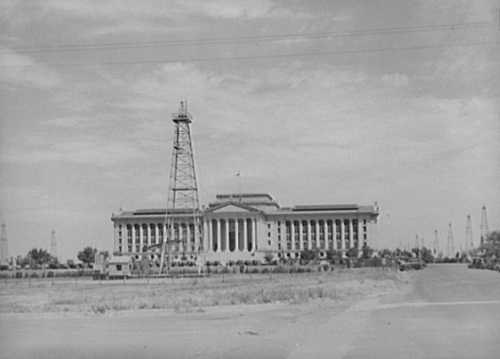
Capitol of Oklahoma with surrounding derricks. Oklahoma City, Oklahoma. Russell Lee, 1939 (image courtesy of the Farm Security Administration, Office of War Information Photograph Collection at the Library of Congress).
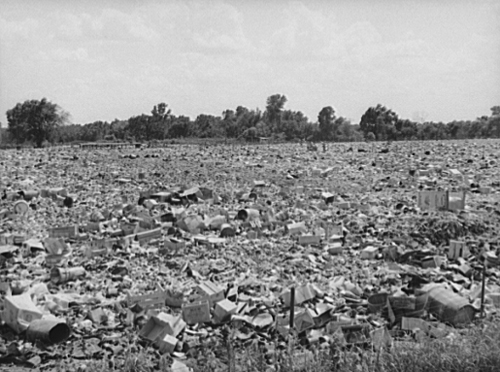
City dump, Oklahoma City, Oklahoma. It was on top of trash such as this that the May Avenue camp was built. Russell Lee, 1939 (image courtesy of the Farm Security Administration, Office of War Information Photograph Collection at the Library of Congress).
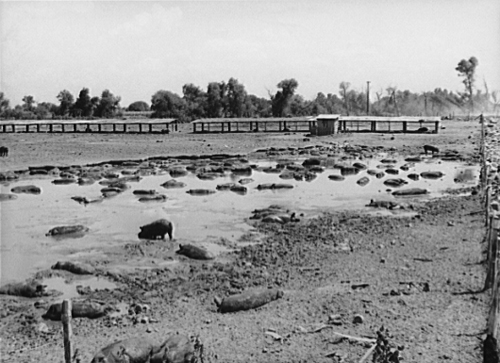
Hog pen and wallow adjacent to city dump. Oklahoma City, Oklahoma. Man who owns hogs rents land from city and also the privilege of feeding them from city dump. Near May Avenue camp. Oklahoma City, Oklahoma. Russell Lee, 1939 (image courtesy of the Farm Security Administration, Office of War Information Photograph Collection at the Library of Congress).
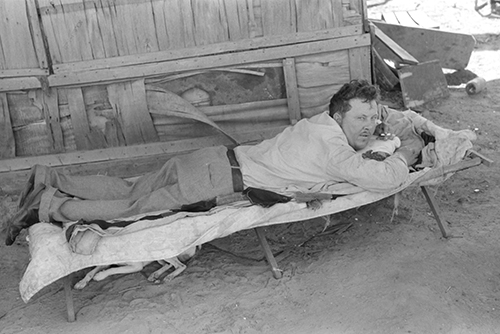
Partially-paralyzed man in May Avenue camp, Oklahoma City, Oklahoma. Russell Lee, 1939 (image courtesy of the Farm Security Administration, Office of War Information Photograph Collection at the Library of Congress).
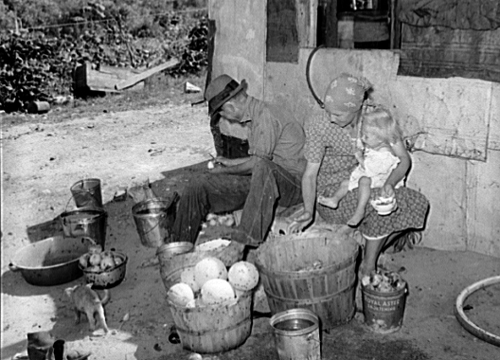
Family living in May Avenue camp. Oklahoma City, Oklahoma. This family had been farmers in Oklahoma until four years ago. Russell Lee, 1939 (image courtesy of the Farm Security Administration, Office of War Information Photograph Collection at the Library of Congress).
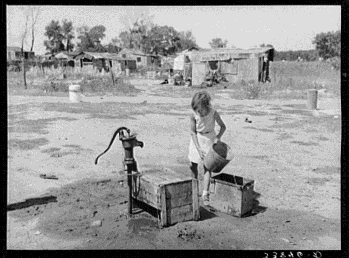
This well was the only water supply for about a dozen families at May Avenue camp. Oklahoma City, Oklahoma. Russell Lee, 1939 (image courtesy of the Farm Security Administration, Office of War Information Photograph Collection at the Library of Congress).
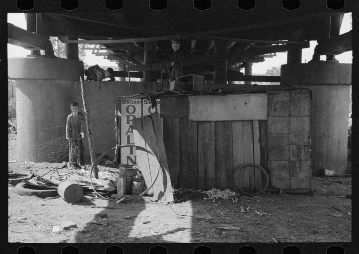
Children in May Avenue camp playing under the bridge. Oklahoma City, Oklahoma. Russell Lee, 1939 (image courtesy of the Farm Security Administration, Office of War Information Photograph Collection at the Library of Congress).
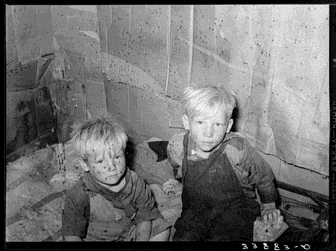
Children of May Avenue camp have a small shack used as sleeping quarters. Oklahoma City, Oklahoma. Russell Lee, 1939 (image courtesy of the Farm Security Administration, Office of War Information Photograph Collection at the Library of Congress).
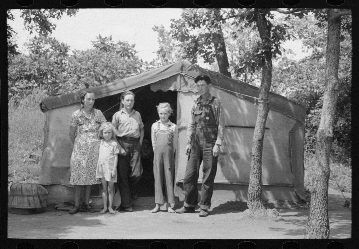
Family of agricultural day laborers living in tent near Spiro, Oklahoma. This family had farmed in this vicinity for twenty-five years but could no longer find a place to rent. They had no money and no car but hoped to get work in the potato fields and chopping cotton and picking roasting ears. They wanted to buy a car and get on to California but if they couldn't make it the man said they couldn't run him out of Oklahoma. Russell Lee, 1939 (image courtesy of the Farm Security Administration, Office of War Information Photograph Collection at the Library of Congress).
The Civilian Conservation Corps
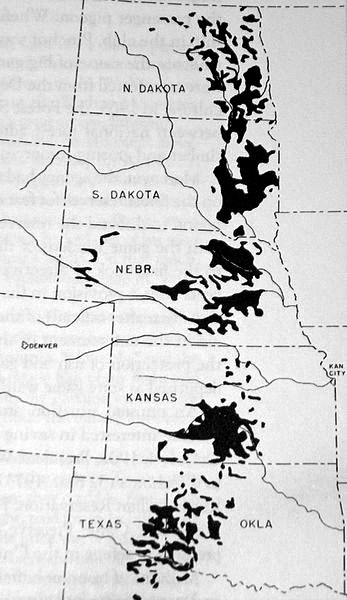
This map shows the forested areas planted as part of the Great Plains Shelterbelt, which began in Greer County, Oklahoma (map courtesy of Wikimedia Commons).
The government made the Civilian Conservation Corps (CCC) to help people without jobs find work, people without homes have a place to live, and to help stop the spread of the Dust Bowl. Young, single men without jobs could apply to work for the CCC. They could have a place to live, food, and some money for their work. Men in the CCC built dams and lakes, and built the first state parks in Oklahoma: Boiling Springs, Roman Nose, Quartz Mountain, Osage Hills, Robbers Cave, Beavers Bend, and Spavinaw Hills state parks.
The CCC also planted many trees. Trees have strong roots that can hold down a lot of dirt. They also act as wind blocks, which helps to stop the dirt from blowing away. The "Number One Shelterbelt" was the first stand of trees planted by the CCC in a national program stretching from North Dakota to the Texas Panhandle. The Number One Shelterbelt is north of Mangum, Oklahoma, in Greer County. Oklahoma's first state forester, George R. Phillips, planted the first tree in this shelter on March 18, 1935. There are almost 3,000 miles of trees that were planted in Oklahoma as a part of this program. Almost 19,000 miles and more than 223 million shelter trees were planted nationwide as a part of this program that started in Oklahoma.
The Public Works Administration and the Works Progress Administration
Congress created the Public Works Administration (PWA) in 1933 to put citizens to work on large-scale building and construction projects as well as road and transportation maintenance. Its largest and most expensive project was the Grand River Project, which spent over $20 million building the Pensacola Dam as well as other dams in the state. Similar to the PWA, the Works Progress Administration (WPA) was created in 1935. Its primary goal was to employ workers to create structures that provided long-term benefits to communities. Each state had its own priorities and ran its own projects. Road-building accounted for half of the projects completed by the WPA, but it also built canals, bridges, dams, post offices, National Guard Armories, schools, and even some sporting stadiums. The WPA also helped the people that it employed. As many people before World War II never finished high school, employees of the WPA were able to complete a high school diploma while working.
The PWA and the WPA also performed many special projects. Some of these projects included the archaeological survey of Spiro Mounds, the preservation of Sequoyah's Cabin, and construction of the replica of the original Fort Gibson. One part of the WPA was the Federal One Project. The Federal One Project hired artists, writers, and actors to create art, write plays, and perform for the public. Many pieces of American art that exist today were made as part of the Federal One Project. It was the PWA that then constructed the Oklahoma City Civic Center Theater and the Oklahoma City Museum of Art.
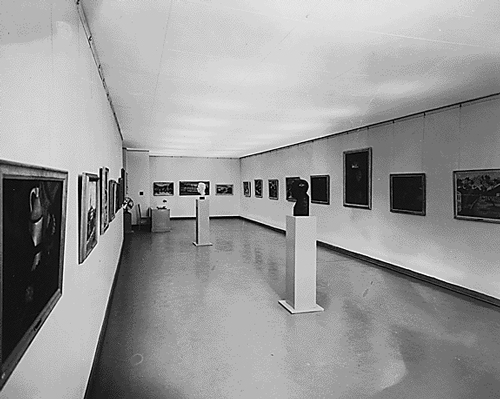
One of the first art exhibits at the Federal Art Center. The Federal Art Center is now the Oklahoma City Museum of Art (image courtesy of the FDR Library and Museum).
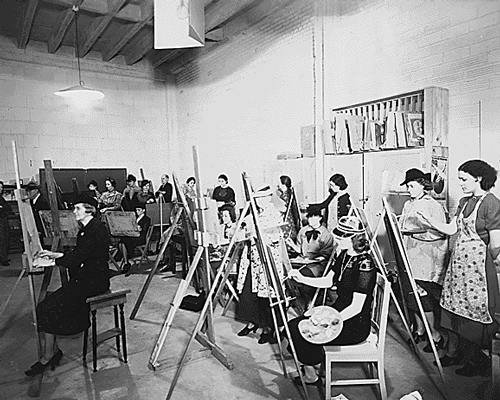
An art class being held at the Federal Art Center in the Municipal Auditorium of Oklahoma City. Today, the Municipal Auditorium is the Oklahoma City Civic Center (image courtesy of the National Archives).
Another set of special projects performed by the WPA were archival projects. This means that the WPA hired people to collect historic records and preserve them in state and federal offices, as well as local libraries and museums. One of these projects sought to collect information on American folk life from around the country. WPA writers collected thousands of oral history interviews, including a collection known as the Slave Narratives. During the 1930s, there were still people alive, who had been enslaved before the end of the Civil War, and WPA writers sought them out and interviewed them about their lives. In Oklahoma, the WPA interviewed about eighty people who were born into enslavement. Their narratives are free to read, and listen to, at the Library of Congress.
The WPA completed many important projects in Oklahoma during its existence. The WPA also employed over 119,000 people in Oklahoma during the Great Depression.
Listen to the WPA's oral history interviews with formerly enslaved people.
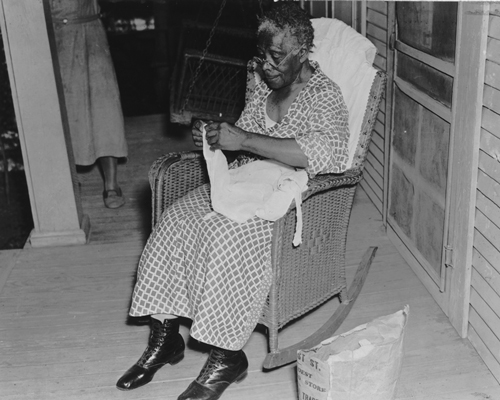
Katie Rowe, age 88, in Tulsa, Oklahoma, c. 1937 (image courtesy of the Library of Congress).

